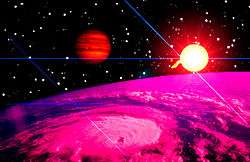Kepler-102
 An artist impression of Kepler-102 (star system close-up view). | |
| Observation data Epoch Equinox | |
|---|---|
| Constellation | |
| Right ascension | 18h 45m 55.86s[1] |
| Declination | +47° 12′ 28.91″[1] |
| Apparent magnitude (V) | 11.492 |
| Characteristics | |
| Details | |
| Mass | 0.8 [2] M☉ |
| Radius | 0.74 [2] R☉ |
| Temperature | 4903 [2] K |
| Metallicity [Fe/H] | +0.08 [2] dex |
| Other designations | |
KOI-82 | |
| Database references | |
| SIMBAD | data |
Kepler-102 is a star with five known planets. Kepler-102 is somewhat less luminous than the Sun.
Planetary system
On January 2014, a system of five planets around the star was announced, three of them being smaller than Earth. While 3 of the transit signals were discovered during the first year of Kepler mission, their small size made them hard to confirm as possibilities of these being false positives were needed to be removed. Later, two other signals were detected. Follow-up radial velocity data helped to determine the mass of the largest planet.[3]
| Companion (in order from star) |
Mass | Semimajor axis (AU) |
Orbital period (days) |
Eccentricity | Inclination | Radius |
|---|---|---|---|---|---|---|
| b | — | 0.055 | 5.28696 | — | 85.37° | 0.47 R⊕ |
| c | — | 0.067 | 7.07142 | — | 87.09° | 0.58 R⊕ |
| d | — | 0.086 | 10.3117 | — | 87.09° | 1.18 R⊕ |
| e | 8.9±2.0 M⊕ | 0.116 | 16.1457 | — | 87.66° | 2.22 R⊕ |
| f | — | 0.165 | 27.4536 | — | 88.24° | 0.88 R⊕ |
See also
References
- 1 2 http://simbad.u-strasbg.fr/simbad/sim-id?protocol=html&Ident=Kepler-102
- 1 2 3 4 http://kepler.nasa.gov/Mission/discoveries/
- ↑ Masses, radii, and orbits of small Kepler planets: the transition from gaseous to rocky planets accessdate=8 January 2014
- ↑ http://astro.berkeley.edu/~gmarcy/22kois.pdf
This article is issued from Wikipedia - version of the 2/21/2015. The text is available under the Creative Commons Attribution/Share Alike but additional terms may apply for the media files.